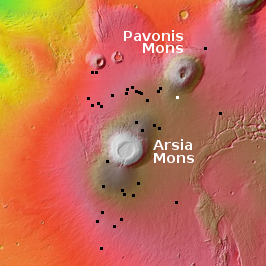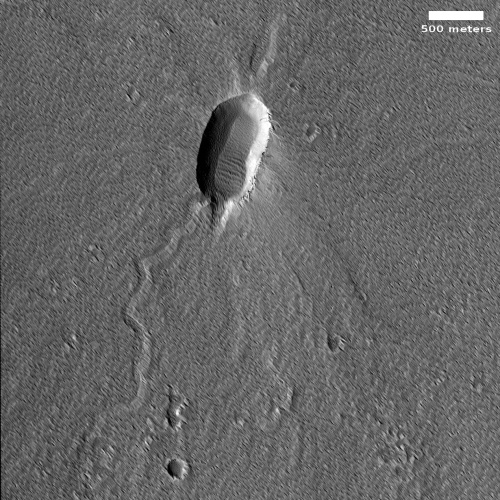An inactive volcanic vent on Mars
Cool image time! The picture to the right, rotated, cropped, and reduced to post here, was taken on October 5, 2022 by the high resolution camera on Mars Reconnaissance Orbiter (MRO). Labeled by the science team as “Vents and Lava Flows on Flank of Pavonis Mons,” the section to the right shows the picture’s largest vent. The downhill grade is to the south.
In the full photo you can see that this vent sits on top of a flat mound of hardened lava, all of which flowed from the vent in the distant past. The main flow of course went to the south, out the channel and down the flanks of Pavonis Mons, the middle volcano in the line of three just to the west of Mars’ giant Valles Marineris canyon. The caldera peak of Pavonis Mons is about 35 miles away, and sits at a height of 47,000 feet elevation, far higher than Mount Everest but still only the fourth highest Martian volcano.
In the full picture, the entire surface also generally flows south, except for a crack that goes from northeast to southwest, possibly caused when the mountain flank sagged to the south.

The white dot south of Pavonis Mons marks this vent’s location. The black dots mark the location of the many pits found in the region surrounding these shield volcanoes.
I call this vent inactive, instead of extinct, because we have no idea if it might someday go live again, even though it is likely a billion years or more since lava actually flowed out. Though at present there is no evidence from orbital images of any recent activity on these giant Martian volcanoes, with the most recent activity millions of years ago on the northwest flanks of OIympus Mons, we really know very little about the conditions on the surface, close-up and in detail. There could still be some minor venting, as well as a magma chamber below ground.
On Christmas Eve 1968 three Americans became the first humans to visit another world. What they did to celebrate was unexpected and profound, and will be remembered throughout all human history. Genesis: the Story of Apollo 8, Robert Zimmerman's classic history of humanity's first journey to another world, tells that story, and it is now available as both an ebook and an audiobook, both with a foreword by Valerie Anders and a new introduction by Robert Zimmerman.
The ebook is available everywhere for $5.99 (before discount) at amazon, or direct from my ebook publisher, ebookit. If you buy it from ebookit you don't support the big tech companies and the author gets a bigger cut much sooner.
The audiobook is also available at all these vendors, and is also free with a 30-day trial membership to Audible.
"Not simply about one mission, [Genesis] is also the history of America's quest for the moon... Zimmerman has done a masterful job of tying disparate events together into a solid account of one of America's greatest human triumphs."--San Antonio Express-News
Cool image time! The picture to the right, rotated, cropped, and reduced to post here, was taken on October 5, 2022 by the high resolution camera on Mars Reconnaissance Orbiter (MRO). Labeled by the science team as “Vents and Lava Flows on Flank of Pavonis Mons,” the section to the right shows the picture’s largest vent. The downhill grade is to the south.
In the full photo you can see that this vent sits on top of a flat mound of hardened lava, all of which flowed from the vent in the distant past. The main flow of course went to the south, out the channel and down the flanks of Pavonis Mons, the middle volcano in the line of three just to the west of Mars’ giant Valles Marineris canyon. The caldera peak of Pavonis Mons is about 35 miles away, and sits at a height of 47,000 feet elevation, far higher than Mount Everest but still only the fourth highest Martian volcano.
In the full picture, the entire surface also generally flows south, except for a crack that goes from northeast to southwest, possibly caused when the mountain flank sagged to the south.

The white dot south of Pavonis Mons marks this vent’s location. The black dots mark the location of the many pits found in the region surrounding these shield volcanoes.
I call this vent inactive, instead of extinct, because we have no idea if it might someday go live again, even though it is likely a billion years or more since lava actually flowed out. Though at present there is no evidence from orbital images of any recent activity on these giant Martian volcanoes, with the most recent activity millions of years ago on the northwest flanks of OIympus Mons, we really know very little about the conditions on the surface, close-up and in detail. There could still be some minor venting, as well as a magma chamber below ground.
On Christmas Eve 1968 three Americans became the first humans to visit another world. What they did to celebrate was unexpected and profound, and will be remembered throughout all human history. Genesis: the Story of Apollo 8, Robert Zimmerman's classic history of humanity's first journey to another world, tells that story, and it is now available as both an ebook and an audiobook, both with a foreword by Valerie Anders and a new introduction by Robert Zimmerman.
The ebook is available everywhere for $5.99 (before discount) at amazon, or direct from my ebook publisher, ebookit. If you buy it from ebookit you don't support the big tech companies and the author gets a bigger cut much sooner.
The audiobook is also available at all these vendors, and is also free with a 30-day trial membership to Audible.
"Not simply about one mission, [Genesis] is also the history of America's quest for the moon... Zimmerman has done a masterful job of tying disparate events together into a solid account of one of America's greatest human triumphs."--San Antonio Express-News



VolcanoCafe, very good website, did a post on volcanism on Mars.
https://www.volcanocafe.org/martian-chronicles-the-living-plume/
What is with the odd, striated terrain — it’s everywhere — that fills the image to the north of the vent, grading into the more granular texture surrounding and to the south of it? Indeed, the vent and the volcanic rille to the north are about the only features in this frame that look “normal” in an earthly / lunar context.
As Robert keeps observing, Mars is a very strange place, but what might have generated these landforms?